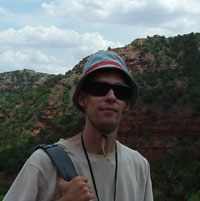
Interested in weather for as long as I remember, I went to Valparaiso University to study meteorology as an undergraduate and then completed graduate school at the University of Oklahoma. I joined the Department of Earth and Atmospheric Sciences at UNL in fall 2011.
Severe weather is a theme underlying much of my research. I have focused on understanding polarimetric radar signatures in supercell thunderstorms, with special emphasis on the near-tornado portion of the supercell lifecycle. My other radar-related work has focused on tornadic debris signatures, rate of winter precipitation, signatures of biological and other non-meteorological scatter, and associations between radar variables and lightning distributions. I also have research interests in synoptic meteorology and forecasting, public perceptions of severe weather threats, and meteorological effects of land use/landcover variability. Outside of traditional meteorological research, I apply polarimetric radar observations to questions in aeroecology in an attempt to understand how birds and insects interact with weather features.
Selected Publications
Van Den Broeke, M. S., M. B. Wilson, C. A. Van Den Broeke, D. J. Healey, M. J. Wood, and R. E. Nelson, 2023: Polarimetric radar observations of a long-lived supercell and associated tornadoes on 10-11 December 2021. Mon. Wea. Rev., in press.
Van Den Broeke, M. S., 2023: Radar indications of altered foraging behavior during the February 2021 severe North American cold wave. Avian Biol. Res., 16, 14-20.
Wilson, M. B., and M. S. Van Den Broeke, 2022: Using the Supercell Observation Research Kit (SPORK) to examine a large sample of pretornadic and nontornadic supercells. Electronic J. Severe Storms Meteor., 17 (2), 1-38.
Bunkers, M., M. Wilson, M. Van Den Broeke, and D. Healey, 2022: Scan-by-scan storm-motion deviations for concurrent tornadic and nontornadic supercells. Wea. Forecasting, 37, 749-770.
Van Den Broeke, M. S., 2022: Bioscatter transport by tropical cyclones: Insights from ten years in the Atlantic basin. Rem. Sens. Ecol. Cons., 8, 18-31.
Van Den Broeke, M. S., 2020: A preliminary polarimetric radar comparison of pre-tornadic and nontornadic supercell storms. Mon. Wea. Rev., 148, 1567-1584.
Van Den Broeke, M. S., 2019: Radar quantification, temporal analysis, and influence of atmospheric conditions on a roost of American Robins (Turdus migratorius) in Oklahoma. Remote Sens. Ecol. Conserv., 5(2), 193-204.
Hu, Q., J. A. Torres-Alavez, and M. S. Van Den Broeke, 2018: Land-cover change and the “Dust Bowl” drought in the U.S. Great Plains. J. Clim., 31, 4657-4667.
Van Den Broeke, M. S., 2017: Polarimetric radar metrics related to tornado life cycles and intensity in supercell storms. Mon. Wea. Rev., 145, 3671-3686.
Van Den Broeke, M. S., 2016: Polarimetric variability of classic supercell storms as a function of environment. J. Appl. Meteor. Climatol., 55, 1907-1925.
Duell, R. S., and M. S. Van Den Broeke, 2016: Climatology, synoptic conditions, and misanalyses of Mississippi River Valley drylines. Mon. Wea. Rev., 144, 927-943.
Jauernic, S. T., and M. S. Van Den Broeke, 2016: Perceptions of tornadoes, tornado risk, and tornado safety actions and their effects on warning response among Nebraska undergraduates. Natural Hazards, 80, 329-350.
Van Den Broeke, M. S., and S. T. Jauernic, 2014: Spatial and temporal characteristics of polarimetric tornadic debris signatures. J. Appl. Meteor. Climatol., 53, 2217-2231.
Van Den Broeke, M. S., 2013: Polarimetric radar observations of biological scatterers in Hurricanes Irene (2011) and Sandy (2012). J. Atmos. Oceanic Technol., 30, 2754-2767.
Van Den Broeke, M. S., J. M. Straka, and E. N. Rasmussen, 2008: Polarimetric radar observations at low levels during tornado life cycles in a small sample of classic Southern Plains supercells. J. Appl. Meteor. Climatol., 47, 1232–1247.